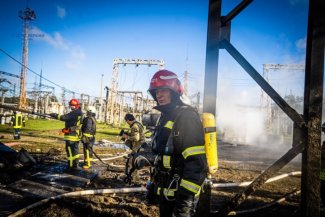Strikes on Ukraine’s energy infrastructure. 239th day of the war

The Ukrainian General Staff has significantly reduced information on the situation in the combat areas. Russian forces are making further attempts to advance on Bakhmut and its outskirts, as well as the southwest and northeast of the city. Defenders also repulsed attacks northeast of Siversk and in an arc west of Donetsk. According to local sources, heavy clashes occurred on the border between Kharkiv and Luhansk oblasts and the northern border between Donetsk and Luhansk oblasts.
The situation in Kherson Oblast remains unclear. Initially, Ukrainian military sources reported Russian shelling of the line of contact to halt the counter-attack by Ukrainian units and the enemy’s expansion of defensive positions. A few dozen hours ago, however, they stopped reporting information indicating that the defenders were conducting active operations on the right bank of the Dnieper. On 21 October, the Ukrainian Operational Command ‘South’ communicated that the enemy was using active defence tactics, and the General Staff – that 2,000 newly mobilised troops had reinforced the enemy grouping. According to unofficial reports, the aggressor’s troops are to withdraw some equipment to the left bank of the Dnieper. However, Russian sources reported unsuccessful attacks by the Ukrainians on enemy positions north of Kherson.
On 20 October, the deputy head of the Main Operational Directorate of the General Staff of Ukraine, Oleksiy Hromov, stated that the primary task of the Russian army was to hold the front line and halt the Ukrainian offensive in the Kherson area. The enemy is concentrating on maintaining the land link connecting Crimea to Russia and establishing a bridgehead for a possible strike on Mykolaiv and towards the Odesa Oblast. To halt the advance of Ukrainian forces, 45 battalion tactical groups have been concentrated in the south. The Russians are fortifying defensive lines and further attempting to restore the Dnieper river crossings. Hromov also does not rule out that enemy troops will partially withdraw from the right bank of the Kherson Oblast and leave forces there to block the Ukrainians’ advances.
Commenting on the situation in Belarus, Hromov said there might be a resumption of the Russian offensive on the northern front. The strike could take place along Ukraine’s western border and aim to cut the main logistical arteries of military supplies going through Poland. The Russian side is taking steps to deploy aviation and other units of the Russian Armed Forces to Belarus, with MiG-31 aircraft at airfields.
On 20 October, the Belarusian Ministry of Defence announced the start of autumn conscription. It is expected to include 10,000 recruits out of the 60,000 required to attend military commissions, as well as 200 reserve soldiers. It is scheduled to end on 4 November (for the Armed Forces of the Republic of Belarus) or 30 November (for other military formations, mainly subordinate to the Interior Ministry).
On 20 October, Belarusian Defence Minister Viktar Khrenin stated that the conflict ‘provoked by the West in Ukraine’ threatens the security of the Republic of Belarus. He declared that weapons supplied to the Ukrainians were being sold on the black market and could end up in the hands of ‘radical-minded citizens’, and that ‘nationalist formations’ involving foreign nationals could enter Belarus. He also said that the Regional Military Grouping of Belarus and Russia was conducting combat duty and reconnaissance activities on the southern border but was ready to respond ‘to provocations in the western and north-western directions’. In turn, Belarus Security Council secretary Alyaksandr Valfovich made it clear that under the banner of ‘nationalist formations’, i.e., Belarusian volunteer troops in Ukraine, regular units of NATO countries may be used, which may seek to ‘unleash a bloody massacre on Belarusian soil’.
Russian forces continue their massive strikes against Ukraine’s energy infrastructure. Missiles have again fallen on thermal power plants in Dnipropetrovsk, Ivano-Frankivsk and Vinnytsia oblasts (Kryvyi Rih, Burshtyn and – once again – Ladyzhyn, respectively). Attacks also targeted infrastructure in Kyiv, Kharkiv, Chernihiv, Mykolaiv, Sloviansk and Zaporizhzhia. Defenders once again reported that they shot down some rockets and most drones. The National Guard of Ukraine has set up 250 stationary and 130 mobile fire teams to destroy them. According to Energy Ministry assessments, 40% of the country’s energy infrastructure has been damaged since 10 October.
Artillery and air strikes by the aggressor against enemy army positions and facilities along the line of contact and in the border regions of Chernihiv and Sumy oblasts are ongoing. On 21 October, for the first time in three and a half months, there was no night shelling or bombardment in Dnipropetrovsk Oblast. The Ukrainian side confirmed another attack on the Antonov Bridge east of Kherson, and, indirectly, the evacuation of civilians from the occupation administration, which was underway at the time of the shelling.
Commentary
- Kyiv avoids providing details of the damage, thus making it difficult to assess whether the estimate of 40% of the electricity system being damaged corresponds to reality. However, the situation is serious. On 20 October, electricity grid operator Ukrenerho decided on emergency power cuts in several circuits. Many cities switched off street lighting and restricted public transport (metro and trolley buses) commuting and energy consumption by industrial plants. According to DTEK – the owner of around 70% of thermal power plants in Ukraine – the main targets of the shelling are not the power plant blocks but the high-voltage nodal switching stations. Their quick repair is only provisional; complete restoration will take at least several months. It is unclear whether Russia will succeed in paralysing the grids across the country, but if the power supply restrictions persist in the coming weeks, the – already extremely difficult – economic situation will be adversely affected.
- The attacks on the energy infrastructure do not directly affect the actions of the Ukrainian forces. Their possible effects on Ukraine’s defence would be derived from the country’s economic situation deterioration. This is because the military has its alternative sources of power (mainly generators) and will use diesel locomotives to transport war material – in the event of disruptions to the electric railway traction. Therefore, the destruction of the energy infrastructure by the Russians must be seen as aimed solely at hampering the functioning of the state and creating a major humanitarian crisis.
- The growing problem with access to data on the military situation in the Kherson Oblast confirms that the Ukrainian side has already begun active operations there, or they are a matter of the next several dozen hours. The first eventuality should be considered more likely. At the same time, the lack of communication should be seen as a consequence of the failure of the first attempts to break through the enemy’s defences. However, it cannot be ruled out that Kyiv has managed to discipline online media over the past month and create an effective information blockade. The inconsistency of the message about the situation on the front was among the biggest obstacles to the authorities’ communication policy and hindered the army’s conduct of operations.
- Information on the scale of conscription to the Belarusian army shows that Minsk does not intend to exceed its peacetime numbers (around 45,000 soldiers). Belarus’ participation in the Regional Forces Group (RFG) will, therefore, realistically be limited to about 15,000 military personnel (the total number of soldiers of the Land Forces and Special Operations Forces excluding garrison service) who could be used in a joint operation with Russia. Including the declared forces that the Russian Federation is currently redeploying to Belarus, the size of the RFG would be limited to 25,000 troops. Even in the case of direct involvement of the Belarusian army in operations against Ukraine, these forces would not be sufficient to carry out another offensive in the north.
- The Minsk regime is using the development of a joint Belarusian-Russian military grouping to divert the attention of its people from the war against Ukraine. The authorities are conducting an extensive propaganda and disinformation operation showing that the threat from NATO and the risk of diversionary troops entering Belarus are growing. This allows them to continue their repression and state management policy under an informal anti-terrorist operation verbally declared by Alyaksandr Lukashenka. By supporting Russia in its aggression against Ukraine, however, Minsk is attempting to reduce the likelihood of its army being involved in combat operations, which would pose a significant threat to Lukashenka.




